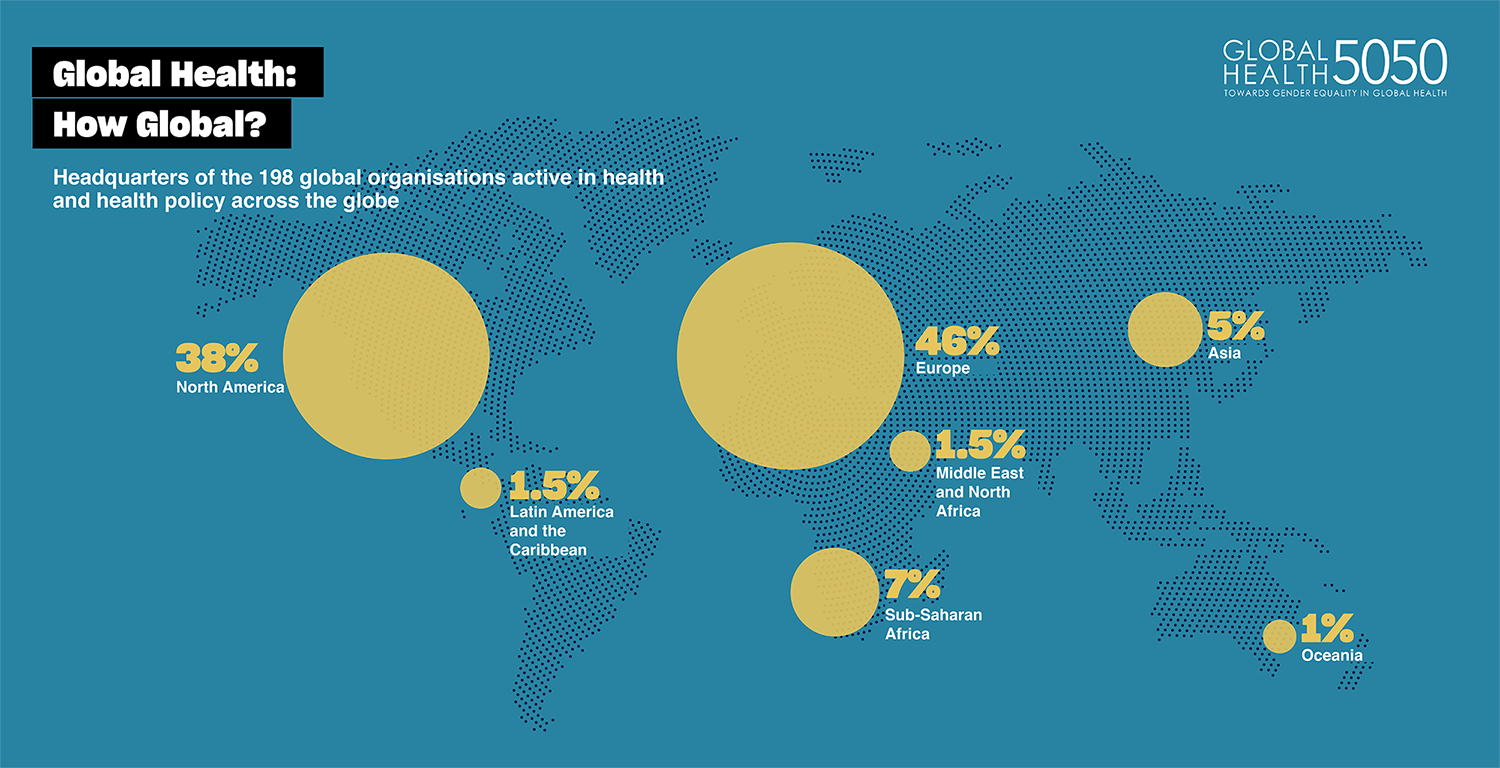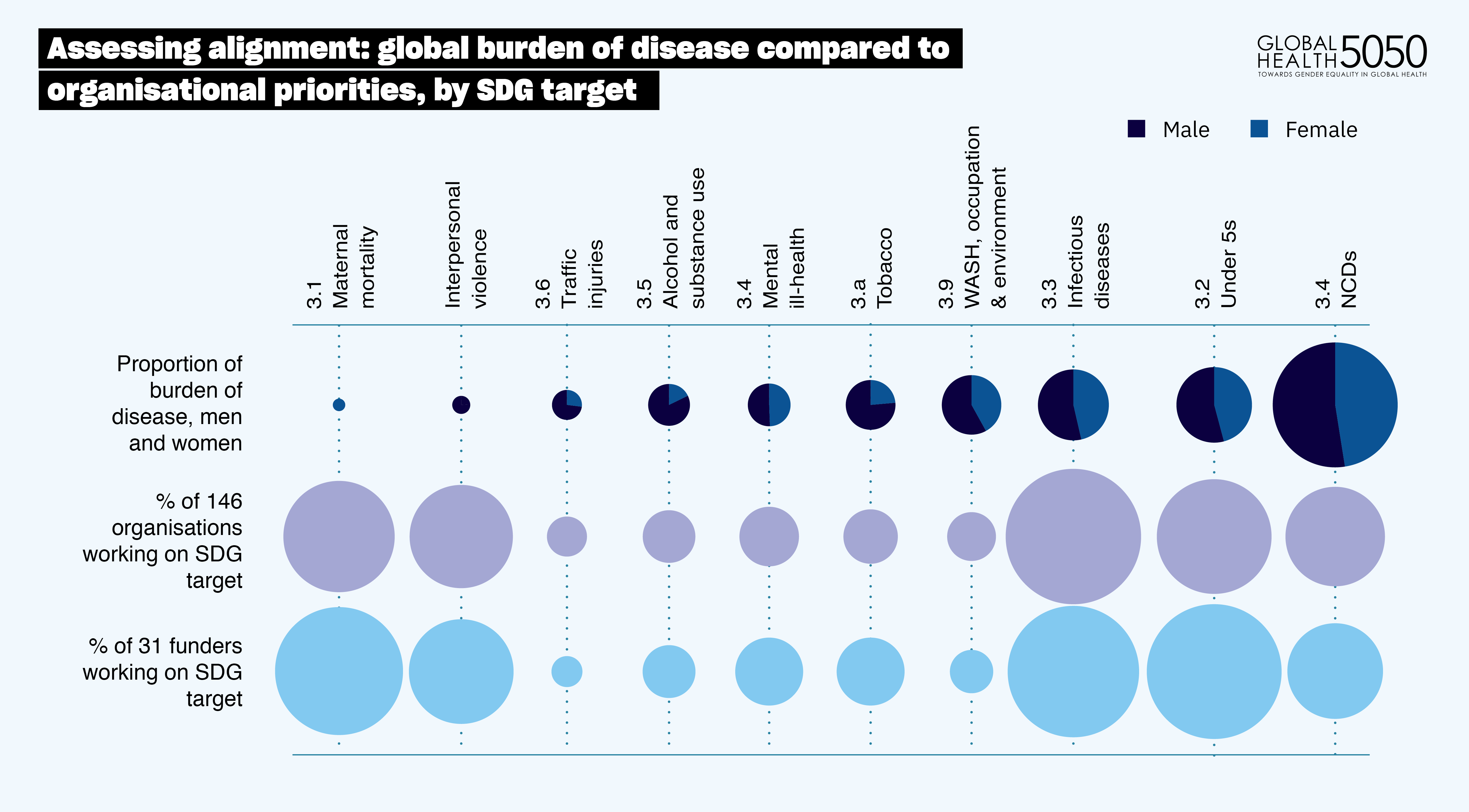2020 Global Health 50/50 Report
Power, privilege & priorities
The 2020 report provides an unprecedented birds-eye view of the global health system today. It reveals that the leadership of the 200 most prominent organisations active in global health continues to reflect power and privilege asymmetries along historical, geographic and gender lines. The report further uncovers a distinct disconnect between the organisational priorities and the gendered burdens of disease around the world.
The report warns that these inequalities -- an inequality of opportunity in career pathways inside organisations and an inequality in who benefits from the global health system -- are impeding progress towards health goals.
Gender and power matter in global health
Gender has a fundamental bearing on how power and privilege are distributed and maintained. Gender norms determine life opportunities, health, well-being and careers.
Gender also acts as a gateway to revealing and understanding opportunity, expectations and achievements along a number of social identities, such as class, geography, ethnicity/race, age and (dis)ability.
Together, these influence whether people-men and boys, women and girls, and people with trans and non-binary identities-can realise their fundamental human rights, including their right to health.
This report urges global health actors and organisations to ramp up action on to build a fairer, more equitable global health system and unleash its full potential.
Benchmarking organisational performance: the Gender and Health Index
Now in its 3rd year, the Global Health 50/50 Report assesses 200 global organisations active in health and health policy. The report publishes findings of the Gender and Health Index across four dimensions:
(1) Commitments to equity
(2) Presence of workplace gender equality and diversity policies
(3) Gender and geography of global health leadership, and
(4) Whether gender is addressed in health policies and programmes.
The Gender and Health Index is the world’s most comprehensive interactive database on gender in global health organisations. It is designed to advance action and accountability for gender equality and social justice in global health workplaces and programmes.
The 2020 Index and Report build on GH5050’s annual analysis. Recognising that gender intersects with other aspects of identity, they include new variables that explore broader systems of power and privilege within organisations. Additionally, they examine the stated health priorities of 150 organisations against the targets of the Sustainable Development Goals (SDGs) and the global burden of disease, to identify which issues and which populations aren’t getting sufficient attention.
Facing up to a broken global health system
The field of global health has long been a beacon for global solidarity. The 2020 Report finds evidence of a growing commitment to issues of equality and of organisations’ ability to make meaningful and rapid change. An inspiring movement to shift power is emerging.
Throughout its history, the sector has transformed itself in the face of changing risks, outbreaks, advances in knowledge and community demand. It can, and must, do so again to effectively tackle the challenges of the SDG era. We know it is needed and we are convinced it is possible.
This report however reveals a broken system that is failing to evolve. The skewed distribution of power, privilege and priorities is undermining global efforts to reach the health-related SDGs. Its failings fall along three fault lines. One, power asymmetries continue to plague the global health architecture. Two, patterns of privilege drive gender inequality and lack of diversity in global health organisations. And three, organisations have not kept pace with changing global health needs and are failing to take gender seriously.
One…
We find that power asymmetries continue to plague the global health architecture
Power asymmetries in the global health architecture are rooted in unfair and unequal relationships arising from economic power imbalances, global governance structures, patriarchal norms and practices and colonialism. Today, 85% of global organisations active in health and health policy have headquarters in Europe and North America, with two-thirds headquartered in just three countries: Switzerland, UK and USA.
Many of the 200 organisations work in low- and middle-income countries. We might therefore reasonably expect to see nationals from these countries represented in positions of decision-making power.
This is not the case. Over 80% of global health leaders are nationals of high-income countries, and over 90% of whom completed their education in these economically rich countries.

Two…
Power asymmetries coupled with patterns of privilege drive a troubling lack of gender equality and diversity in leadership
Despite the recent wave in attention to clearing the path for women’s ascent in the workplace, the number of women reaching the top has barely budged in the global health space.
73% of executive heads in our sample are men. Those reaching the top are not just defined by their gender but also their geography. Just 5% of leaders are women from low- and middle-income countries.
From 2018 to 2020, the percentage of female CEOs increased by 1%. This isn’t merely a result of slow turnover at the top. On average, one in five organisations under review welcome a new CEO each year. Simply, men continue to be succeeded by other men.
Confronting the 70-80-90 ‘glass border’ in global health:
More than 70% of leaders in our sample are men, 80% are nationals of high-income countries and 90% were educated in high-income countries
Progress towards gender parity in decision-making bodies is being made. The percentage of organisations with at least one-third women in senior management positions has grown from 56% to 65%.
Will we wait 54 years until gender parity in global health decision-making?
Only 28% of senior management teams have reached gender parity (45-55% women), up from 25% in 2018. At the current rate, we will not reach gender parity in senior management across global health organisations until 2074.

Three…
Global attention has not kept pace with changing global health needs and is failing to take gender seriously
The SDGs set the most comprehensive agenda to date for advancing health and well-being for all. A dedicated goal on health (SDG 3) includes 13 targets to drive action on the greatest health challenges facing the global population.
An analysis of the health-related priorities of the organisations in our sample, however, reveals notable gaps. We find a startling mismatch between organisational attention and burden of disease. Maternal and child mortality and infectious diseases continue to receive the most attention, issues which were predominant in the era of the Millenium Development Goals (MDGs; 2000-2015). The SDG targets for 2030, particularly NCDs, are not receiving proportional attention from funders or other organisations. This is despite the fact that NCDs cause the most premature deaths globally.

Despite the role gender norms plays in driving health inequities, there are a lack of strategies to address this. For some Sustainable Development Goal targets (e.g. on alcohol, tobacco, substance use), the burden of ill-health in men is much greater than in women. Yet the vast majority of organisations make no distinction between the health-related risks and needs of women and men.
Change is possible
Notable improvements have been made since the first GH5050 report.
Over the past two years, the number of organisations declaring a commitment to gender equality and the availability of policies to advance gender equality in the workplace have substantially increased. The proportion of women board chairs jumped from 20% to 26% in the same period.
In contrast, a common definition of gender in line with global norms is still not applied across the sector. The resurgence of political opposition to the notion of ‘gender’ requires global health to be clear and unified in their support of the concept. Progress towards gender parity in decision-making bodies is slow, though we recognise that change will take time.
Growing policy commitments to equality mark an important step forward. It remains to be seen whether staff and leadership will embrace such policies and translate them into organisational change and more equitable outcomes for people.

From commitment to action
Commitment to gender equality among global organisations active in health is on the rise. But commitment on paper must be translated to action and impact.
We believe that the health and well-being of people around the world will benefit from-and require-diverse leadership. Drawing on the findings in the 2020 Global Health 50/50 report, GH5050 calls on the global health community to face up to a broken system and the patterns of the past in order to forge a fairer, more effective system. We must address power and privilege imbalances and redress historic inequalities. Together let us demand a more critical, political understanding of the sector, and for action to stamp out the causes of health inequities around the world.

